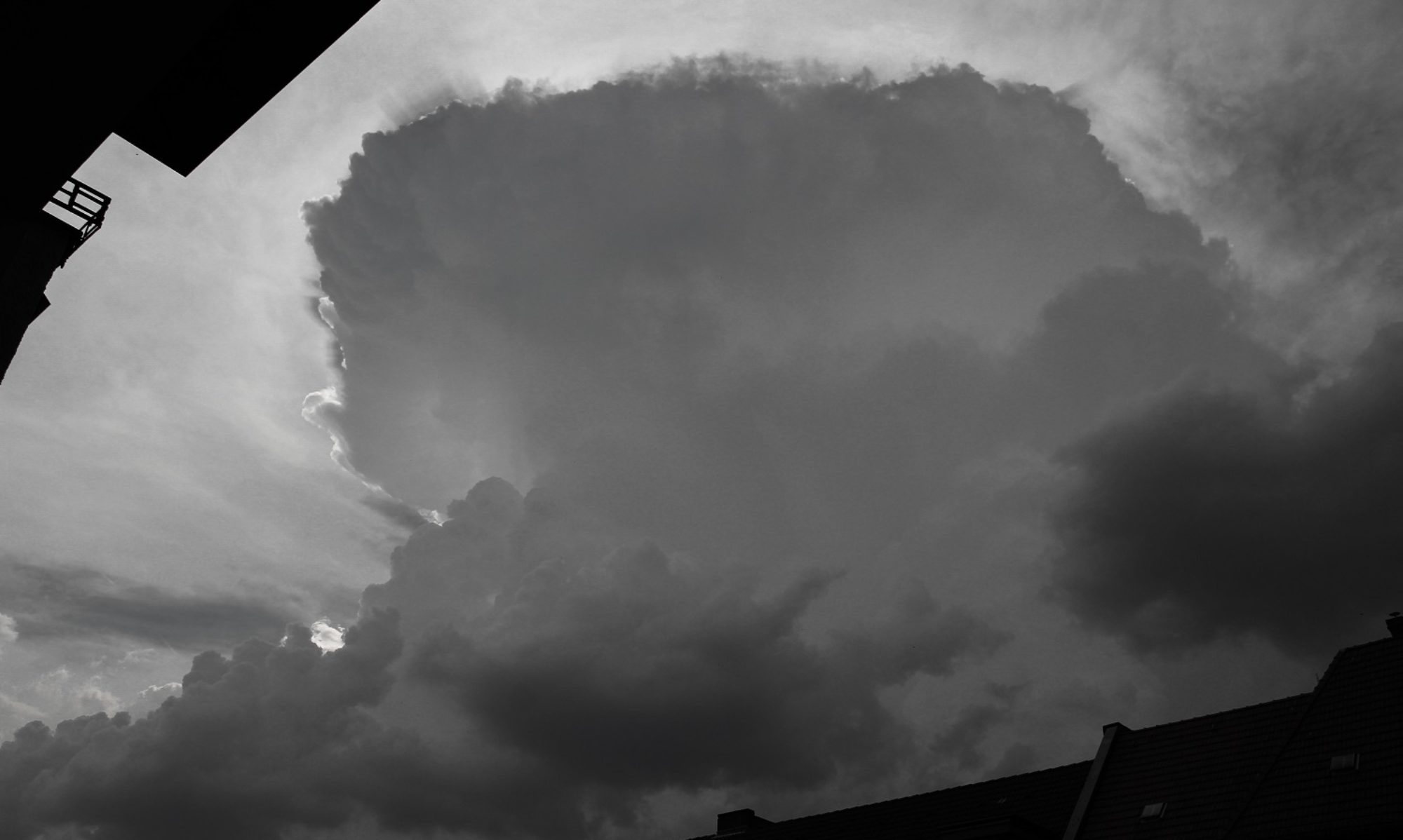English version can be found below.
An und hinter der Kaltfront des Sturmtiefs “Bennet”, dessen Kern sich morgen im Laufe des Tages von den Britischen Inseln kommend über die Nordsee schließlich in die Ostsee verlagert, sind schwere Sturmböen zu rechnen. Schon seit einigen Tagen rechnen alle Wettermodelle mit vergleichsweise kleinen Unterschieden mit diesem Sturm, der das gesamte Bundesgebiet Deutschlands betreffen wird.

Oben haben wir die vorhergesagte Wetterlage für Montag, 12UTC (also 13:00 Ortszeit). Man beachte das Tief mit Kern in der Nordsee. Der Prognostizierte Kerndruck liegt bei 975hPa. Von dem Tief erstreckt sich eine Kaltfront über Deutschland, die Alpen, Südfrankreich bis nach Spanien und Portugal. Besonders entlang dieser Kaltfront, die sich (in Richtung der Dreiecke) im Wesentlichen von West nach Ost über Deutschland bewegen wird, sowie hinter ihr, ist mit den stärksten Sturmböen zu rechnen. Generell gilt auf einer Wetterkarte: Je näher die Isobaren (also die Linien gleichen Luftdrucks) zusammenliegen, desto stärker der Wind.
Besonders im Norden Deutschlands können sich sogar einzelne Gewitter bilden. Diese bergen dann die Gefahr in sich, noch deutlich stärkere Böen die eventuell auch Orkanstärke erreichen könnten (d.h. über 120 km/h) mit sich zu bringen.
Einige Vorhersagemodelle rechnen derzeit auch mit der Ausbildung einer Böenfront im Norden Deutschlands, an deren Vorderkannte deutlich stärkere Sturmböen als im meisten Restlichen Land zu erwarten wären. Das sieht man auf der Kart hier ganz gut:

Das Vorhersagemodell von Meteo-France rechnet zwar im Allgemeinen mit einem weniger starken Sturm als die sonstigen Vorhersagen, allerdings erwartet es auch eben die vorhergenannte “Squall-Line” (Böenfront) im Norden Deutschlands, und rechnet innerhalb dieser sogar mit Böen von bis zu 140 km/h. Zwar besteht die Möglichkeit dafür, da allerdings die restlichen Vorhersagemodelle mit einer nicht ganz so extremen Ausprägung rechnen, ist aber relativ unwahrscheinlich.
Auch hier erkennt man die prognostizierte Böenfront und ihre Position jeweils zur vollen Stunde, da sie sich, wie der Rest des Wetters, von West nach Ost über das Land bewegt:

Die Karte oben zeigt die höchsten Windgeschwindigkeiten an, mit denen dieses Modell von Kachelmannwetter im Laufe des gesamten Tages rechnet. Man sieht, dass insgesamt fast überall mit Sturmböen oder auch schweren Sturmböen von um oder auch über 90km/h zu rechnen ist. Evtl. kann es auf den Berggipfeln, an den Küsten und an sonstigen exponierten Orten auch noch etwas darüber kommen. Außerdem sollte man die mögliche Böenfront im Norden Deutschlands im Auge behalten, entlang der es – vor allem in Kombination mit eventuell auftretenden Gewittern – doch noch etwas happiger kommen kann.
Vorhersage: LH
English
Along and behind the cold front of a storm by the namet of “Bennet”, which will move from the British Isles by way of the North Sea and into the Baltic Sea over the course of the day tomorrow, severe storm gusts are to be expected. Forecast models have been expecting this storm for several days and with relatively small discrepancies between them, and expect it to affect all of Germany.

Above, you can find the predicted atmospheric conditions for Monday, 12UTC (so 13:00 local time). Note the low pressure area, the center of which is located in the North Sea with a predicted pressure of 975 hPa. Coming from the low, a cold front extends across Germany, the Alps, southern France and all the way to Spain and Portugal. It will progress in direction of the triangles, so largely from west to east across Germany. Along as well as behind this front is where the strongest storm gusts are to be expected. A general rule for weather maps is: the closer together the isobars (lines of equal pressure) are, the windier the conditions.
Especially in the north of Germany, some thunderstorms may form, too. These carry the risk of bringing even stronger storm gusts within them and in their vicinity. These gusts may reach hurricane force, so exceed 120 km/h.
Some forecast models currently also expect the formation of a squall line (a gust front) in the north of Germany, at the leading edge of which there could be notably stronger storm gusts than in the rest of the country. You can see this potential situation quite well on this map:

The forecast model by Meteo-France expects a weaker storm in much of Germany than most of the other forecasts, however it is also predicting the aforementioned squall line in the north of the country, and expects it to bring wind speeds of up to 140 km/h. Though the possibility of this taking place cannot be ruled out, the other forecast models don’t expect quite as extreme wind speeds, and therefore, it seems unlikely that the squall line should reach such an intensity.
In the next map, you can also see the squall line. In this case, you can see its location at the top of each hour, as it progresses from west to east (along with all the rest of the weather) across Germany:

The above map shows the highest wind speeds that this weather model by Kachelmannwetter expects over the course of the entire day. You can see that almost everywhere, storm gusts or severe storm gusts of around but also above 90 km/h are expected. Coasts, mountain peaks and other exposed areas may experience even higher wind speeds. Furthermore, one should keep an eye on the potential squall line in Norther Germany, which – especially in combination with possible thunderstorms – might pose a particular risk to life and property.
Forecast: LH

